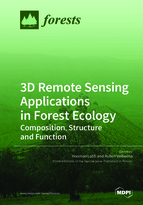3D Remote Sensing Applications in Forest Ecology: Composition, Structure and Function
A special issue of Forests (ISSN 1999-4907). This special issue belongs to the section "Forest Inventory, Modeling and Remote Sensing".
Deadline for manuscript submissions: closed (31 July 2019) | Viewed by 42127
Special Issue Editors
2. Department of Photogrammetry and Remote Sensing, Faculty of Geodesy and Geomatics Engineering, K. N. Toosi University of Technology, Tehran, Iran
Interests: ecosystem monitoring; vegetation health; time series remote sensing; LiDAR
Special Issues, Collections and Topics in MDPI journals
Interests: forest ecology; remote sensing; LiDAR; forest inventory; tree size scaling theories; forest structure; competition and dominance; modelling; data fusion
Special Issues, Collections and Topics in MDPI journals
Special Issue Information
Dear Colleagues,
The composition, structure and function of forest ecosystems are the key features characterizing their ecological properties and can, thus, be crucially shaped and changed by various biotic and abiotic factors, ranging from global, continental and sub-continental climate change to macro- and micro-climatic regimes, disturbance agents and anthropogenic factors. The constant and alarming rise in the magnitude and extension of these changes during recent decades calls for enhanced cross-border and cross-continental mitigation and adaption measures, which strongly entail intensified monitoring in both space and time. In the absence or shortage of expensive logistics and field surveys, remote sensing data and methods are the main complementary sources of synoptic, up-to-date and objective information for forest ecology. Owing to the fact that forest ecosystems (and the influential factors shaping them) are inherently of a three-dimensional nature, methods based on the analysis of three-dimensional sources of remote sensing data can be considered the most appropriate tools to retrieve the forest compositional, structural and functional dynamics. Examples of these data include a broad range of methods for 3D reconstruction (stereo-photogrammetric restitution, structure from motion, interferometry, ranging, etc.) obtained using various remote sensors (digital images, LiDAR or RADAR) from a variety of platforms (ground-based, UAV-borne, airborne or spaceborne). Whereas many applications rely on the sole use of either of these data sources to answer a specific question, combined or fused applications have also received considerable attention during recent years.
In this Special Issue of Forests, we encourage state-of-the-art scientific works from all relevant fields, including experimental studies, method developments, model validations and reviews dealing with the general topic of 3D remote sensing-assisted applications in monitoring forest composition, structure and function. In particular, contributions covering the following sub-topics are welcome:
- 3D remote sensing-assisted analysis of forest composition
- Tree species classifications, with particular focus on bottlenecks such as broadleaves, rare tree species, and ecosystems only marginally studied with these methods, such as aquatic forest ecosystems
- Operational, large-scale monitoring of forest composition
- Combination and fusion of 3D and 2D sources of data form forest composition analysis
- Advanced application of 3D sources of data for deriving forest structural attributes:
- Algorithm development (in particular for tree object extraction, predictive and extrapolative models and automatic process chains for them)
- Model validation and uncertainty analysis
- Optimization of field- and remote sensing sampling schemes
- Calibration and transferability of models across space and time
- Remote sensing-assisted studies on community ecology with particular focus on the structure or forest understory, deadwood or herbaceous plants
- 3D remote sensing-assisted analysis of forest function
- Watershed-related analysis across forest landscapes using 3D sources of data
- Erosion monitoring across forested landscapes
- Characterization of wildlife habitats and niches using 3D sources of data
- 3D applications for forest functional diversity monitoring, in particular across degraded, transitional or disturbed landscapes.
- Advancements in modeling, prediction and extrapolation of forest wood and non-wood forest products
With this Special Issue we aim at showing applications in forest ecology in a broad collection of methods/sensors/platform combinations. We therefore encourage submissions employing uncommon data fusion schemes and novel perspectives.
PD Dr. Hooman Latifi
Dr. Ruben Valbuena
Guest Editors
Manuscript Submission Information
Manuscripts should be submitted online at www.mdpi.com by registering and logging in to this website. Once you are registered, click here to go to the submission form. Manuscripts can be submitted until the deadline. All submissions that pass pre-check are peer-reviewed. Accepted papers will be published continuously in the journal (as soon as accepted) and will be listed together on the special issue website. Research articles, review articles as well as short communications are invited. For planned papers, a title and short abstract (about 100 words) can be sent to the Editorial Office for announcement on this website.
Submitted manuscripts should not have been published previously, nor be under consideration for publication elsewhere (except conference proceedings papers). All manuscripts are thoroughly refereed through a single-blind peer-review process. A guide for authors and other relevant information for submission of manuscripts is available on the Instructions for Authors page. Forests is an international peer-reviewed open access monthly journal published by MDPI.
Please visit the Instructions for Authors page before submitting a manuscript. The Article Processing Charge (APC) for publication in this open access journal is 2600 CHF (Swiss Francs). Submitted papers should be well formatted and use good English. Authors may use MDPI's English editing service prior to publication or during author revisions.
Keywords
- Forest ecology
- Forest structure, composition and function
- Three-dimensional remote sensing
- Data fusion
- Spatiotemporal analysis
- Causal and predictive modeling







